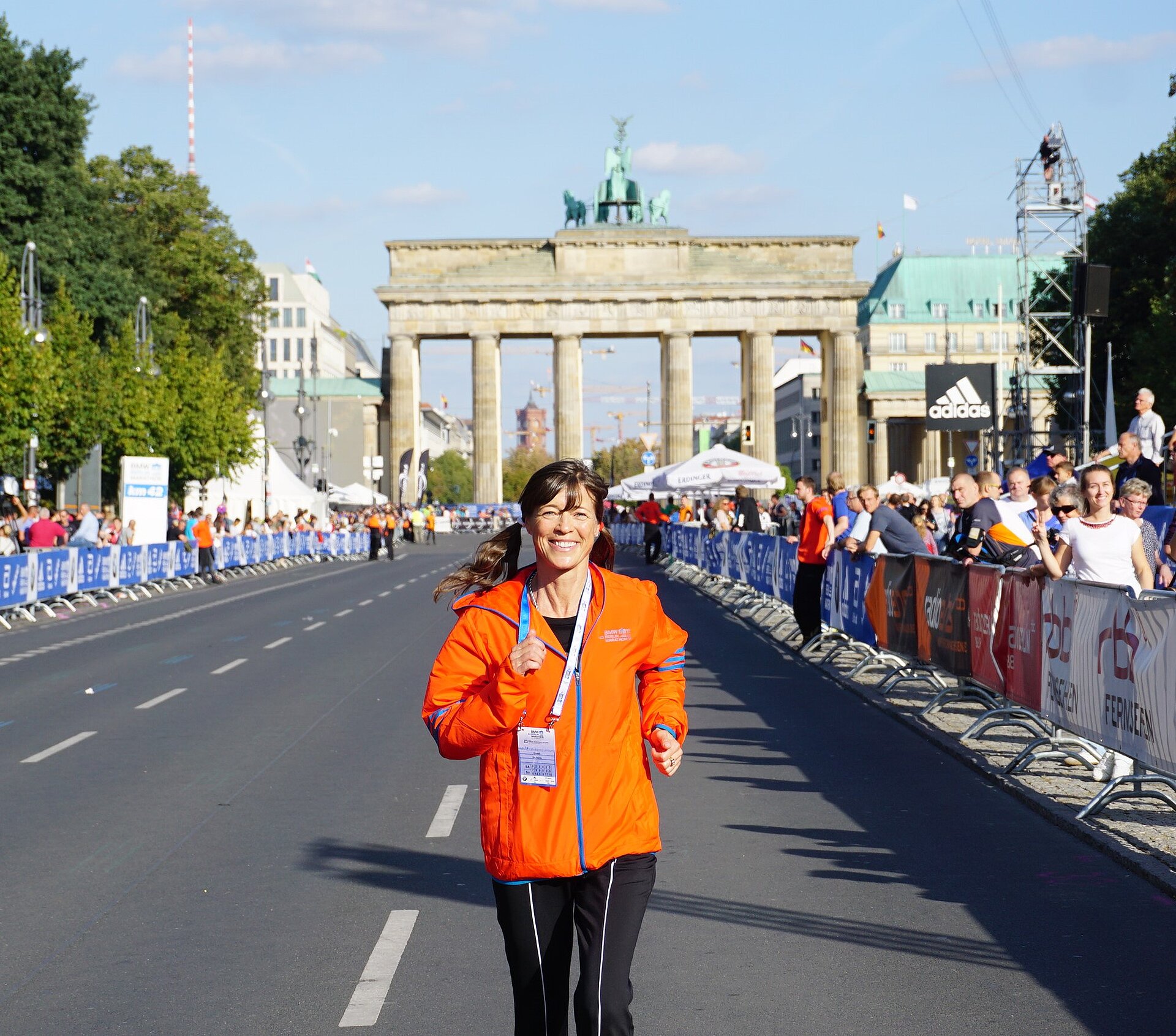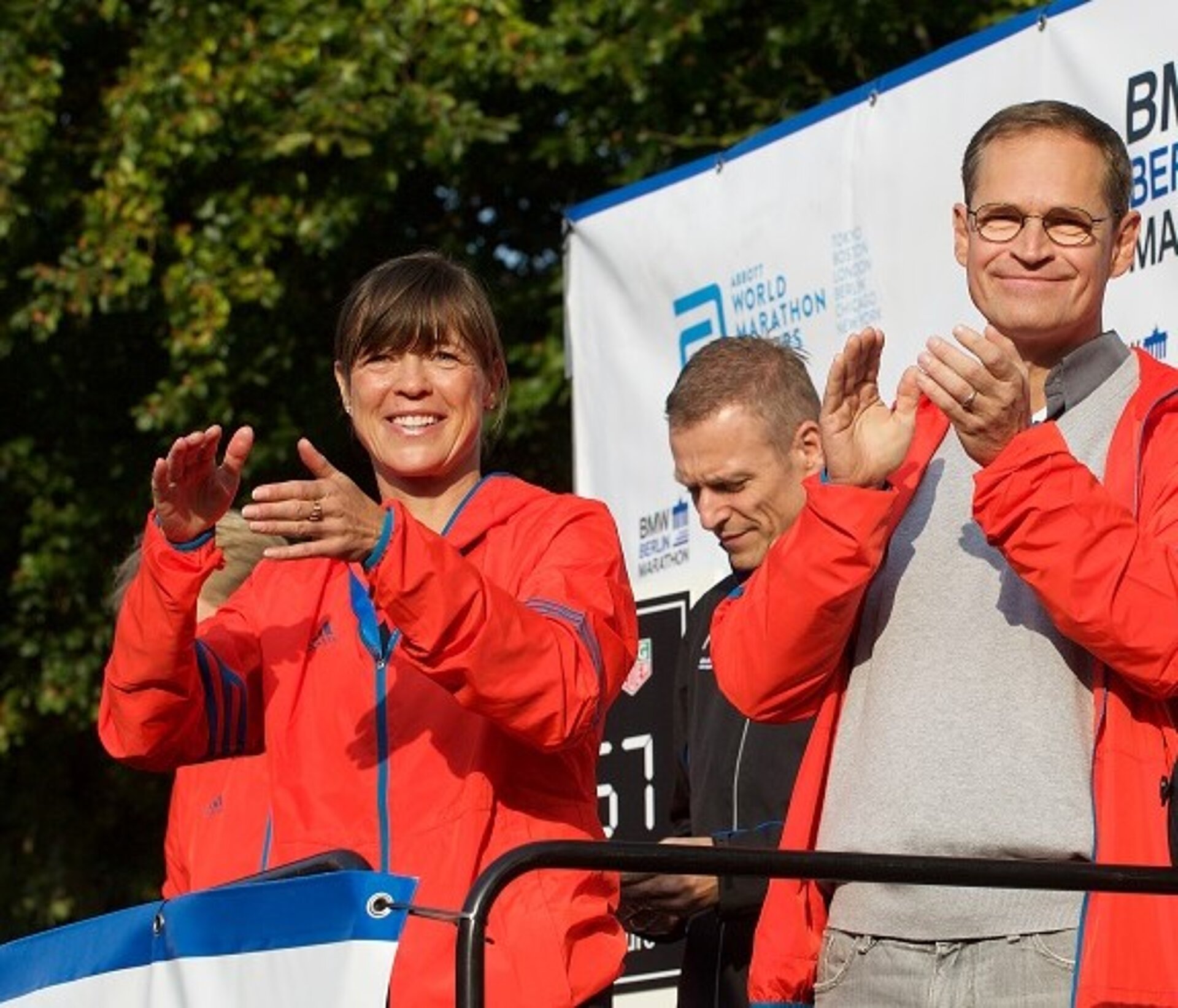Uta Pippig is one of the most successful marathon runners of all time. The pictures of her victory at the 1990 BERLIN-MARATHON, the run for reunification, went around the world. Born in Leipzig, she began her career at the age of 13 in the GDR, winning the GDR championships over the marathon distance in 1986 & 1987.
After winning the BERLIN-MARATHON in 1990, she repeated this feat in 1992 and 1995, as well as three victories in Boston and a win in the New York Marathon. After her active career, she moved to the USA, where she founded and still supports several charities. She is committed to helping disadvantaged children and young people.
Uta has been a columnist for "Die Welt" and the running magazine "Laufzeit & Condition" since 2016. On her website, everyone - from beginners to professional athletes - can benefit from her expertise. Uta helps wherever she can. She is also an important advisor for the BMW BERLIN-MARATHON and the Marathon Team Berlin.
1. Running Technique: Each Athlete is unique
It is common to adapt your running style to your individual body characteristics. Before you start intensive training, I recommend an analysis of your running style - many running centers or stores offer this.
It is advisable to regularly check and adapt your individual running technique. Changes should be made slowly and gradually and sufficient time should be allowed for each adjustment. If necessary, you should seek the help of a qualified running coach.
- Feel how your head sits over your neck. Make sure it is not tilted forward or backward. For your own safety, look ahead and keep an eye out for movements around you as well as uneven surfaces below your feet.
- When the arms and shoulders are moving, they are relaxed, with the shoulders being held straight, not rounded. Your arms move like a pendulum in an even rhythm and in sync with the legs, letting your shoulders hang loose and gently swing with the movement of the arms. Hold the arms close to the side of the body, lower arm and upper arm at approximately a right angle, while keeping the elbow joint relaxed. Make a loose fist or leave your hands almost open and swing them past the waist.
- Focus on a natural upright body posture. Some people run with their legs too far in front of the center of their bodies, in a more sitting position, others bend too far forward. Your center of gravity, which is located approximately in the midpelvic cavity — between the joint of the pubic bones and the belly button —, should move up and down as little as possible while running. You can check this by looking straight forward and running so that the horizon in front of you appears to be only slightly moving up and down.
- Your feet land slightly on the outer side, but predominantly on the entire sole of the foot, slightly in front of the center of gravity. Then roll inwards towards the arch of the foot, while the weight is shifted to the ball. Use feet and legs as one unit by pressing your foot off the ground, using your hamstrings as well as your butt muscles to move your hip forward while the leading leg is preparing to take the next step. Observe the position of your knee: Do not lift it so high that the thigh is parallel to the floor.
Running is a natural movement that requires little attention. This checklist is an aid if you want to check or refine your technique. Only ever make small adjustments - slowly, step by step. Allow yourself enough time for each change, they are not beneficial or advisable for everyone. Seek advice from a running coach.
Yours, Uta
2. Overview of the different Training Periods
Thorough marathon preparation is crucial for your success. Make sure you go through each training period in detail and remember: recovery is just as important as the training itself.
Take your individual goals and fitness level into account when planning your training. Slowly increase the length and speed of your runs and make sure you get enough rest.
Base period
Begin with the base period, which normally takes six to eight weeks. The focus is on the continuous development of your general fitness. This gives you the base endurance and strength to be able to train more specifically during the subsequent training periods. First, it is about a strong foundation that can always be built on. The duration of the base period can be shortened, for example, if you have recently completed a marathon. In that case, after a fairly short recovery period, you are ready to start your next marathon preparation using your form and fitness.
First and second build-up period
The first build-up period with a duration of up to three weeks will include higher mileage and longer runs. After a recovery week, the second build-up period will follow – again for three weeks – with the highest mileage and longest runs.
„Tapering”-Period
Finally, you will reach the tapering period, or “reduction“ period, which involves shorter and some faster runs. Be sure not to train too intensively so shortly before your race. Train smart — less is sometimes more. Decide on intensities that you can master well and which, rather than tiring you, will make you fit for the coming race. This period is usually scheduled in the last three weeks before the marathon. Some elite athletes "taper" even longer.
Recovery week
Recover well between each individual training period. Many runners take six to eight days — generally known as a "recovery week". During this time you will strengthen your body and mind in preparation for the next period by processing the workload of the previous period and starting the next one at a higher fitness level.
Good luck with your training and, most importantly, have fun doing it.
Yours, Uta
3. First Build-Up Period
After the basic period comes the first build-up period of marathon preparation. Here the longer runs are extended.
Make sure to increase your fitness slowly according to your individual plan and your target time to avoid overtraining. The following principles will prepare you optimally for the second build-up period, which is usually carried out six to three weeks before the race and involves the highest mileage and longest runs.
Concept of periodization
Follow the concept of periodization by completing an easy week of running after a longer period of hard training. A good plan provides up to three weeks of hard and intensive training followed by a recovery week with easy and less intense running.
Increase the mileage
A basic principle of training in the first build-up period is to increase the mileage of your long runs, which are called "marathon-specific runs" from 18 miles up. For beginners, this means being able to complete between 15 to 18 miles at the end of this period - for competitive athletes, it can be up to 22 miles. Follow the number of your marathon-specific runs from your individual training plan.
For beginners and advanced runners:
If you feel comfortable with the distances of your long runs, you can also gradually increase their pace. I recommend that you first master the mileage before you increase the speed.
Training principle of "Negative Splits."
Start all runs at a slower pace than you finish them by following the training principle of "Negative Splits". That means taking it easier for the first miles, then running faster the second half of the run.
For our beginners:
In addition to the marathon-specific runs, you can also plan one tempo session per week. This can be a fast tempo run that starts at medium pace or, for those who already have attained good speed, an interval training, such as an 800-meter program.
For our intermediate and advanced runners and elite athletes:
Some of you will have already begun a weekly interval training, like a 1000-meter-program. In the first build-up period, this should be part of your plan, and can be extended in the second build-up period. Gradually increase the volume of these programs as well as the distances of your medium and fast endurance runs.
Keep an eye on the subsequent, second build-up period, so always train with reserves. Try to get into good shape and train in such a way that you are able to finish the current training period in good shape. After a week of recovery, you will feel fresh and motivated again so that you can achieve the best training performance of your preparation in the second build-up period.
I wish you good results for these important training weeks.
Yours, Uta
4. Tips for your Recovery Weeks
Recovery is crucial for successful marathon preparation. It is just as important as the running training itself and makes it possible to find a balance between exertion and recovery.
This keeps the mind fresh, concentration levels high during training and prevents injuries. During the recovery periods, damaged muscle cells are repaired and physical performance is improved. A typical recovery week between training periods strengthens the body and prepares it for the next level.
The following advice refers to the recovery week after the end of your basic period (about three months before your race) and the first build-up period of your marathon preparation (about two months before the race). You can add, compare and supplement them according to your specially tailored training plan.
This applies to beginners
Compared to the hard and intensive training weeks, your recovery week should only have a total distance of 50 to 60 percent. The same applies to the mileage of your longest run during this week. Choose lower speeds for your main running sessions. Begin at a relaxed pace and accelerate in the second half — but only if you feel recovered enough from the hard training weeks you just have completed. Once again: Beware of too much intensity! Some strides are an exception — they offer a great addition. Add them to your plan twice during your recovery week, preferably after your shorter and easy runs.
This is how advanced runners proceed
Compared to the hard and intense weeks of training, a total distance of 50 to 65 percent is planned for each recovery week, as well as a 50 to 60 percent duration of your longest run of your hard training weeks. The speeds for the main training sessions should be lower to allow for proper recovery. And your longest distance in these easy days? Many of my athletes would complete up to 10 miles for their longest run and found that to be sufficient.
In the middle of the recovery week I recommend a lighter interval session, for example a 200- to 300-meter program, at the earliest four days after completing the previously hard training period. Run these intervals only playfully and with enough reserves to loosen up your muscles and not overwhelm them with new intensities. I would definitely refrain from high intensities in your recovery week. The exception would be a scheduled competition, but then postpone the start of the next intensive build-up period by a few days.
This applies to runners who want to run faster than three hours
For the respective recovery week, only plan a total distance of 60 to 65 percent compared to the hard and intense training weeks. Decide wisely the distance for your longest run. Avoid a mileage of more than 75 percent compared to the hard training weeks and choose a moderate pace, but only if you have already recovered well for five to six days. Your detailed plan will give you additional information. In the middle of your recovery week, about four days after the previously completed hard training period, you can run a light, short interval program. I recommend, for example, a 300- or 400-meter-program.
Listen to your body
And advice for all runners: Prolong your recovery week by a few days if you are not feeling well rested. It is important to take enough time to be able mentally as well as physically to start the new hard training period. Also, during your training periods, listen to your body. If you feel prolonged fatigue and higher muscle tightness than usual, have less appetite, or experience a change in your sleeping pattern, these are all signs of possible overtraining. Allow yourself to take a step back and give yourself a few easier days than planned. On these, a good massage can be very helpful. You can also add cross-training, such as swimming or cycling, even if your program does not include it.
I wish you success and a good balance between your workouts and recovery,
Yours, Uta
5. Second Build-Up Period of your Marathon Training
After a recovery period, the second build-up period of your training begins with more intensive and longer runs. It is important to follow some general training principles during this period too.
The second build-up period, around six to three weeks before the race, is crucial for developing endurance and speed toughness. It is therefore important to make the most of every training day.
Prepare yourself well for each marathon-specific run — the 18- to-22 mile runs, sometimes even 25 miles for those with more ambitious time goals. These are demanding workloads for the entire body, so work-free weekends are an ideal opportunity for them. I suggest that you train a little less intensely a day or two before your longest run, sleep well, and pay attention to proper hydration and carbohydrate-rich foods.
A day after, a corresponding regeneration is necessary: easy running, sometimes alternative training like swimming or cycling, warm baths and sauna, a massage, perhaps.
Not too close to the marathon
The longest marathon-specific run should be not later than three weeks before the marathon, ideally during the last days of your second build-up period.
The second focus of the week is building your speed to race pace and faster. This is the tempo run, which is performed near the anaerobic threshold and thus in the area of the desired marathon race pace. It helps improve stamina and develops speed endurance. For beginners it is enough to do a session near the anaerobic threshold once a week. Advanced runners can add interval training.
Stay mentally positive
You may get the feeling that the long running sessions are getting too much. Have courage and self-confidence. Try not to give in to those doubts, stay mentally positive. Just think from one session to the next, as in the marathon, from one 3-mile segment to the next. Every day will bring you closer to your goal.
Use the long runs to create your race strategy. From the beginning, try to find a rhythm that you can master well and that you can hold over the entire distance. Run the first half slower than the second. Also “test drive” the “speedy” running shoes you want to wear in the marathon, as well as the nutrition and fluid intake you have chosen for before and during the run.
Recover sufficiently between training sessions
Proper recovery between each workout is important to staying healthy, avoiding overtraining, and making optimal progress. This will increase your fitness faster and improve your shape. You will thus "secure" your training results during the second build-up period and build on them in the following "tapering" period ("reduction" period). This is important for a good result.
Seek help quickly if you are injured or if you have other health problems. Now is not the time to wait. It may happen that you are under stress with the marathon fast approaching. But there are still some training weeks ahead of you. Stay calm and focused even if your plan is slightly delayed. With this positive attitude, you will be able to gain the necessary mental energy for your marathon preparation and for other tasks and goals in your life.
I will keep my fingers crossed for you in this second build-up period. Remember — with each additional run you will be better prepared. The tapering and thus the recovery from your long runs will soon follow. Keep it up!
Yours, Uta
6. The Tapering-Period
The long runs and the training period with the highest mileage are now behind you. It's time to recover physically and get mentally fit for your marathon day.
In the next weeks, this tapering, i.e. reducing the amount of training, will mean completing some shorter and faster runs. The following general tips will give you information on training, nutrition, race strategy and important recovery. Keep a "cool focus“, which I will explain in my next training article.
Cut back on your mileage gradually
Starting three weeks before your event, reduce to roughly 70 percent of the average weekly mileage of your previous build-up period. During the second week drop down again to about 60 percent, and the week before your race run even less—down to about 40 percent.
Add shorter and slightly faster workouts
Plan your uniquely-tailored schedule according to your current fitness level. Run all your workouts, even the more intensive sessions, with plenty in reserve and rest longer between intense workouts for a full recovery. Also, start every intense workout at about the same speed you could manage during the previous build-up period. Once you find your rhythm—and if you feel strong—maybe after one third to one half of the program run as fast as you can manage while always being in control. A little kick at the end of the session would be great.
Rest and relaxation
Sufficient rest and recovery are necessary and effective tools that should not be underestimated. They will help you get into the best shape for your race. Feel comfortable with taking an additional day off if you need to, because you don’t feel fully recovered yet. You may also decide on an easier workout. Your body’s recovery—week by week feeling more rested—is important at this stage of training so close to your race. Sleep well, aided by prudent planning of your travel and last-minute preparation for the final week.
Focus on proper nutrition
Also make sure you eat a good diet with plenty of fluids and the right carbohydrates, such as oat products, rice, beans, potatoes and pasta, as well as good fats, i.e. those with monounsaturated fatty acids, such as those found in olive oil, avocados, nuts and seeds, and those with omega-3 fatty acids, such as those found in cold-water fish like sardines, herring and salmon, as well as organic free-range eggs and flaxseed products. To support the recovery of ligaments, tendons and muscles, make sure you consume sufficient protein, especially in the first week of your tapering period. During the last week before your marathon, focus on increasing your carbohydrate intake to bring your glycogen stores to an optimal level.
“Cool Focus”
Tapering provides a great opportunity to check that you are best prepared mentally. I hope you are already getting excited, with a “cool focus” as I like to call it. Closer to race day you may find your energy levels are higher and your mood more uplifted. Your focus on all the aspects of the marathon will be sharpened; you will feel ready to plan your unique race strategy. Evaluate the times you ran during the weeks of your highest mileage period and now during your tapering period, and how your body felt. This information will help you decide on a time goal that feels comfortable and realistic. I often waited until my last important workouts—even up to 10 days before the race—to finalize my race strategy.
Listen to your body
And another piece of advice: listen to your body's signals during your tapering period and during the marathon! It is your best advisor, constantly giving you information about your health, fitness and energy levels. Use this to your advantage. Your body will help you to run a great race.
I wish you good luck for your remaining training.
Yours, Uta
7. Keeping a „Cool Focus“
Only a few days left until the BMW BERLIN-MARATHON! Keep a calm focus, save energy, enjoy the relaxed training days and relax during the preparations.
A relaxed approach increases your chances of reaching your full potential in the race. Use these general tips to prepare yourself mentally.
Plan all details
Plan your travel and logistics details for the last days including race morning. By now, I hope, your travel plans to Berlin are complete. If you live closer by you will have worked out how to get to the start on race morning and, to a lesser extent, where to meet your friends and family after your run. When all this is planned and organized your mind will be at ease. You can keep a “Cool Focus” and sleep well — getting much needed rest before your marathon.
Stay calm
Stay calm and help your body to recover with high quality sleep. By keeping the final days relaxed and without stress, you can help your body achieve optimal mental and physical strength on race day. You have done your preparation and now is the time to recover. Getting enough sleep will help you to have a fresh mind and to stay focused. A race can be such a mental game. Play it strong! Among other benefits, adequate sleep will help strengthen your immune system, build and repair muscle tissue, and sharpen your mental focus — all leading to a better performance. It is helpful to adjust your sleeping pattern so you get used to waking up at the necessary time on race morning.
Go through your race strategy again, think about your marathon time goal - but don't let it stress you out! Enjoy the process of recording all the stats, calculate the times you can derive from the training results in the peak mileage weeks and the tapering phase, remember how your body felt during the training process. This will help you decide on a time goal that you feel comfortable with and that you can realistically achieve. Postpone the final decision until the last few days before the marathon. Perhaps take another look at the marathon course, familiarize yourself with the surroundings and local conditions. Also take into account how well you are physically and mentally recovered. If you have any minor health or training problems, stay calm and take these into account when drawing up your race strategy.
Take the weather forecast for race day seriously and make sure you have the right clothing for all eventualities. Be aware that air conditioning in offices and hotels is a potential risk of catching a cold. This also applies if you are in public areas or surrounded by lots of people.
No experiments!
Don't try anything new at this stage. Now is not the time to experiment with new equipment, nutrition or a new running style. Your body has become accustomed to your typical routine. Stick to what you have tried, what you have been successful with and what you believe in. This will put you in a good position to stay injury-free and run your best race with healthy self-confidence.
It's normal to be a little nervous, especially if you're running a marathon for the first time. Don't doubt yourself, keep a "cool focus". Enjoy the tapering period - the days with less running effort and feeling better and better about your "running form". All of this should be a joyful process until the very last moment. Enjoy the support of family and friends, they will give you wings during the race!
Tips for your trip to Berlin
Pack your running gear in your hand luggage. Once you are in town settle down quickly, make sure you know where you need to go. Maybe visit the expo. Many runners enjoy the exuberant atmosphere of pre-race events, while others like to hibernate and rest all day long, checking one more time their shoes and bib number.
I hope you can keep a “Cool Focus” and be at ease. As I said: It is natural to feel a little nervous from time to time — but see that as a positive sign. Your mind, just like your body, is getting ready to be top fit! I am thinking of you and wishing you a wonderful marathon.
Yours, Uta
Drink plenty of liquids immediately after the race, use the food and drinks available at the finish. Some light food can be good for your body now. Wrap yourself in an insulated foil blanket or something similar, so that the body temperature does not drop too fast! Slip into dry, warm clothing as soon as possible, including fresh socks and a comfortable pair of shoes that provide enough room for your swollen feet. And do not hold back: hug yourself…and embrace your loved ones. They kept their fingers crossed, cheered and supported you during the long marathon preparation and race.
Try to use the rest of the day to make yourself feel good again. It is normal to be thirsty and hungry for a long time. Eat small amounts of easily digestible food. Too much at one time can quickly lead to an upset stomach. Fruit and sweets, rice and pasta are good choices. They are rich in carbohydrates. Give the digestive system some time to return to its normal function. Lying down and relaxing makes sense. A short walk followed by a gentle massage helps recovery and improves muscle relaxation; the metabolism in the muscle cells are stimulated. Listening to music, celebrating with friends in the evening are great ways to round off a special day — all with your medal on your chest. If you cannot sleep due to exhaustion, do not stress it, just relax; follow your feelings. If you are awake, enjoy your success.
In the first few days, recovery is the highest priority. A lot of rest, walks, easy jogging, and alternative training will help you recover faster. Examine and treat small open wounds, chapped skin or blisters to ensure that increased inflammation does not occur. For larger problems consult a physician. Anyone who is in a foreign city and can enjoy a little vacation for a few days after the marathon is one of the luckier ones. Try a bit of sightseeing with long walks. Light movement increases blood circulation, helping to restore oxygen and nutrients to the muscle cells. Stretching exercises are good, but always stretch very carefully and only after a short run. Spoil yourself with your favorite food. Enjoy the change from your extensive training routine.
The „Post-Marathon-Blues”
For a long time your body and mind were totally focused on those 26.2 miles. Everything was about preparation and anticipation, and now that is behind you. Feeling "lost" after a marathon is completely normal. Finding new goals will help you out of this situation. For example it might be a good time to analyze the past preparation and training results while they are fresh in your mind and see what worked and what didn’t. This can help you set positive goals for any future preparations. It sometimes can be easier to get out of the post-marathon blues helping a fellow runner or friend or to motivate others. This will give you new wings!
Back to training
Runners often say they need to get back to training as soon as possible to maintain a high performance level. But the opposite is the case. Allowing the body to fully recover can provide a stronger platform for running faster times in future races. You also give the mind a break from the constant focus on an intense training program and from the overall stress. Even if you do not feel tired anymore, still keep the mileage low and combine running with cross training. This will allow you to stay active, have variety, and at the same time allow for profound recovery.
Increase the specific running training only gradually. Increase the number of runs before you return to longer runs. Easy fartleks and workouts in profiled terrain should be part of your rebuilding beginning weeks three or four after your race. This way it will be easier for you to progress to more intense and tougher training. If possible, it best to run on gentle ground after the many previous asphalt workouts.
A smooth recovery will help you to reintegrate into other areas of your life which you may have been missing due to all your training. Enjoy this re-entry. Savor it… until the marathon fever grabs you again — and you start with more serious training.
Recover well! Until your next marathon adventure!
Yours, Uta







































